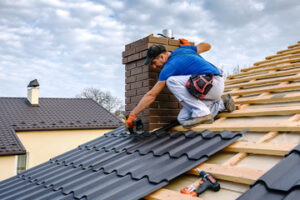Your dock is a valuable asset that requires routine inspections and maintenance. Ignoring minor issues can lead to expensive repairs later on.

Make dock maintenance a priority by scheduling time for it. Having a set date makes it less likely to get lost in the shuffle. Contact Lake Norman Dock Builder for professional help.
Stain and preservatives should be applied regularly using products that are environmentally conscious and designed for outdoor use. Doing so in the fall and winter when water levels are lower reduces the likelihood of weed/algae growth.
A dock is a valuable asset on waterfront property. Whether it’s the home for your boat or the place to hang out and relax on sunny days, a well-maintained dock helps maximize the enjoyment you get out of your waterway experience. Regular cleaning and inspection help to ensure that your dock remains safe, functional, and attractive for years to come.
During the cleaning process, look for signs of rot or decay, splintered wood, and rust on metal hardware. Any of these issues may cause safety hazards for visitors and create structural problems. These should be repaired promptly to avoid further damage and keep everyone using the dock safe.
Start by applying a cleaning solution to loosen caked-on dirt and debris. There are a number of commercial cleaning products available, but it’s important to choose environmentally-friendly and biodegradable options to avoid increasing the nutrient pollution on surrounding waters and potentially harming aquatic organisms. A scrub brush and biodegradable soap work well, but a pressure washer can make quick work of more stubborn stains. Be careful when using a power washer, however, as high amounts of water pressure can damage the materials on the dock.
Following the cleaning process, reseal the dock to safeguard against moisture and UV exposure. There are a variety of sealants and coatings available for different wood types, environments, and conditions. Be sure to follow the manufacturer’s guidelines for application and reapplication of the product.
Performing seasonal maintenance for docks can be especially important in cold, northern climates and areas that experience freezing weather. For example, if you have a floating dock that can’t be removed for the winter, a de-icer or dock bubbler can help circulate water and prevent damage to pilings. It’s also a good idea to cover the dock in the fall to help protect against the elements and snowfall.
A thorough inspection of the dock is just as important as cleaning. During the inspection, pay special attention to crevices and corners, which are where dirt can collect and rust may accumulate. In addition, examine the decking for any loose boards or nails and splintered surfaces. Also, look for rusted hardware or screws and check that swivels and other moving parts are secure.
Sealing
If you’re a waterfront property owner, your docks are among your biggest assets. The best way to make sure they’re always ready for the boaters and swimmers who use them is through regular inspection, cleaning, protection from the elements, and prompt repairs. These measures will help ensure that your docks last long and continue to be a source of pride.
The first step in protecting your dock is to seal it. This will keep dirt, debris, mildew, and other contaminants from clinging to the surface, which can lead to wood rot. Choose a water-repelling product that is designed for your dock’s environment, and be sure to follow all manufacturer instructions.
It’s also important to reseal your dock periodically. This will protect it from moisture and prevent rot, which can shorten the life of your dock.
When it comes to resealing, consult a professional to get the job done right. Incorrect techniques can result in splinters that could be a safety hazard for everyone who uses your dock.
Besides keeping your dock looking its best, resealing will help protect it from rot, mold and other costly problems. It’s also a good time to check for gaps around dock levelers and overhead doors, which can add up to $1,600 to $3,500 per year in energy costs.
Many businesses opt to manage their dock maintenance with in-house staff, but some choose to outsource the task. Both strategies work, though, and both can help control maintenance costs. Hisea Dock, for example, offers a comprehensive maintenance service that can identify potential maintenance issues and develop a maintenance schedule to keep your dock in top condition.
Repairing
The best way to ensure the longevity of a dock is by routinely inspecting it and making repairs as needed. These routine inspections should include checking for loose boards and fasteners, rust or corrosion on metal components, bending and warping, rot, soft wood, fungus growth, and other structural issues that can affect the safety of users. It is also a good idea to check for debris that may have accumulated in areas of the dock to prevent clogged drains and other damage.
Inspecting a dock should also include looking at its structure and foundation. Loose or rotting boards should be replaced promptly. If the wood is damaged, it should be treated with a wood preservative or water-resistant sealant.
A good time to treat wood docks is during the fall and winter when temperatures are cooler and moisture content is lower. These conditions are less damaging than the summer heat and salty sea air that can quickly cause a dock to deteriorate.
When it comes to repairing a dock, some jobs can be done by the homeowner with DIY skills and basic tools. However, more complex jobs such as addressing structural concerns or electrical problems are best left to professional dock builders and contractors.
It’s also important to keep in mind that the cost of a dock repair can vary greatly depending on the severity of the problem and its extent. For example, cleaning a dock by hand or with a pressure washer can cost around $100, while green algae and moss removal costs $250 to $3,000. Foundation or hurricane damage can cost up to $33,000 to repair if the entire structure is unsafe or must be removed and replaced completely.
For this reason, some property owners choose to invest in a planned maintenance program for their dock. While these programs do not eliminate the need for reactive maintenance, they can cut down on it by 20% or more. This can save a business money on workers’ compensation claims and other expenses that can significantly impact the bottom line. In addition, planned maintenance programs can extend the lift life of dock equipment and translate into better return on investment.
Lighting
A dock is a great place for people to enter and exit boats, but that also means that the area needs to be well-lit for safety reasons. This is especially true for the walkways, as someone walking on a dimly lit dock is more likely to fall and hurt themselves. Adding lights along the walkways can help keep everyone safe, and it’s a good idea to put them where they will not bother others or cause too much light pollution.
Docks are exposed to the elements year-round, and neglecting maintenance can lead to serious damage and expensive repairs. Inspecting a dock regularly can help prevent many of these issues.
Start by checking for wood rot and decay in areas that are most often wet, including boards on the edge of the dock and any structures near the water. You should also look for signs of corrosion on metal parts of the dock. Checking the pier legs for damage, rust, and corrosion is important as well. If the legs are corroded or damaged, they may need to be replaced.
Clean the dock regularly with environmentally friendly cleaners, as harsh chemicals can damage the wood or aluminum boat dock. This is particularly important in warmer climates, where green algae tend to build up quickly. Algae and other microorganisms can make a dock slippery, creating a safety hazard for anyone using it. Regular cleaning and the use of anti-fouling paint can help reduce these problems.
Other components of a dock to inspect include the fender systems and bumpers. These can be damaged by abrasion and marine organisms, and they need to be replaced promptly. It’s also a good idea to check that handrails are secure, and there are clearly marked signage indicating weight limits, no diving areas, and other safety rules.
When it comes to maintaining a dock, it’s always best to seek the advice of a professional. These experts can identify potential maintenance issues and develop a comprehensive plan for keeping a dock in top condition. Their services can minimize if not eliminate costly emergency repair and renewal costs, and they can also save dock owners time and hassle.

